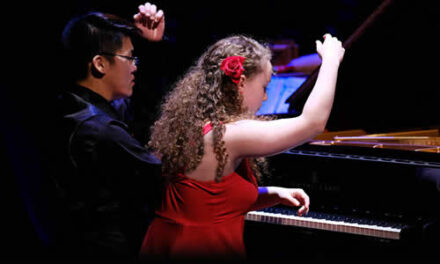One of the major attractions of the Classical Concert Series, presented by the Arts Council of Moore County, is the opportunity to hear talented musicians at the beginning of their careers. The series regularly features recent winners of such major awards as the Young Concert Artists International Auditions or Avery Fisher Career Grants. Violinist Caroline Goulding, 2009 winner of the former and 2011 winner of the latter, made a welcome return to the series in the intimate Sunrise Theater. She was accompanied by Russian-born pianist Dina Vainshtein, who had accompanied the then 18 year old Goulding on her Southern Pines’ debut in 2011. Among Vainshtein’s awards is a Special Prize for Best Collaboration at the International Tchaikovsky Competition in Moscow.
Goulding’s eclectic and unhackneyed program opened with Sonata 21 in E minor, K.304, by Wolfgang Amadeus Mozart (1756-91). It is one of seven sonatas he composed in Mannheim and Paris while on tour in 1778. The historical significance of these is that “they are the first to give the violin a role of substance and importance.” according to Melvin Berger in Guide to Sonatas. Mozart’s mother, who accompanied him, died in Paris; K.304 was composed in the summer after her passing. Alfred Einstein calls it a “miracle.” The 22 year old composer seems to have poured his grief into this sonata, producing a work that throbs with drama and passion. In two movements, it is a case study in classical restraint, barely containing raging emotions. The tension is sustained from the opening of the Allegro’s distinctive unison melody. The troubled emotions lurk under the more peaceful Menuetto movement.
Goulding played intensely with a fine, rich tone, good intonation, and stylish phrasing. Vainshtein balanced her dynamics perfectly, scaling back the sound of the Steinway D Grand to suggest a fortepiano. The pair fully conveyed the remarkable rich emotions of this early masterpiece.
The violin sonatas of Robert Schumann (1810-56) are very rarely heard in our region. At her local debut, Goulding had featured the Sonata No. 1 in A minor, Op. 105, with which the composer was dissatisfied. For this concert, Goulding chose Sonata No. 2 in D minor, Op. 121, composed two weeks after Op. 105, and with which the composer was pleased. It is in four movements labelled in German. The majestic slow introduction leads to broadly and turbulently treated contrasted subjects in which the composer often employs canon. Two linked middle movements follow. A scherzo second movement dominated by a driving rhythm leads to a choral melody that anticipates the theme of the variations of the third movement. The finale contrasts stormy waves of sound against a lyrical second subject, leading to the radiant splendor of an extended coda.
Both Goulding and Vainshtein increased the dynamic range and richness of sound in order to convey the surging Romanticism of Schumann’s increasingly troubled maturity. String intonation was precise and Goulding’s tone was plusher than in the Mozart. Vainshtein balanced the piano ideally with her string partner, and there was nothing wanting in the quality of their ensemble playing.
The well-known Sonata in A (1886) by César Franck (1822-90) brought the concert to a splendid conclusion. In it, Franck employs his characteristic cyclic technique, linking themes and creating one of the most voluptuous sonatas in the repertoire. Goulding and Vainshtein turned in a superb, richly satisfying performance. They produced a plush but elegant sound. A highlight was the ethereal quality as Goulding spun out the gorgeous, heart-aching melody of the second movement.
Clean multiple stops were just some of the delights of Goulding’s playing of her encore, the Rondeau en gavotte from the Partita No. III in E minor, S.1006, by Johann Sebastian Bach (1685-1750).












